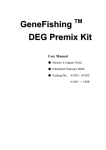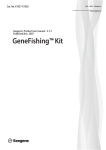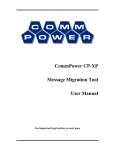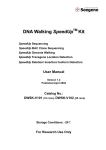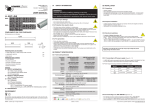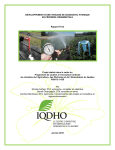Download 2. GeneFishingTM DEG Kits
Transcript
DEG Kits User Manual Version 2.2 Published August 2003 Catalog No. DEGK 3101 ~ DEGK 3106 Storage Conditions: -20℃ For Research Use Only Product Warranty and Liability Seegene warrants the performance of all products as described when used according to instruction. Any problem incurred for any reason, other than misuse, should be reported to Seegene immediately. This warranty limits our liability to replacement of the products. Safety Warning and Precautions This product is limited for research use only, not recommended or intended for diagnosis of disease in humans or animals. Do not use internally or externally in humans nor animals. Ordering Information and Technical Services Seegene, Inc. 142-21 Samsung-dong, Kangnam-gu Seoul, 135-090 Korea Tel: + 82 2-566-9830 Fax: +82 2-566-9831 E-mail: [email protected] URL: www.see-gene.com www.see-gene.co.kr Seegene USA PO Box N Del Mar, CA 92014-0376 USA Tel : + 858-610-9610 Fax: + 858-623-9610 E-mail: [email protected] URL: www.see-gene.com The PCR process is covered by patents owned by Hoffman-La Roche Inc. No license or immunity under any other patent is either expressed or implied by the sale of any Seegene product. www.see-gene.com 2 Table of Contents 1. What is ACPTM Technology? --------------------------------------------------------------- 4 2. GeneFishingTM DEG Kits -------------------------------------------------------------------- 6 3. Power of GeneFishingTM DEG Kits ------------------------------------------------------- 7 4. List of Components --------------------------------------------------------------------------- 11 5. Storage Conditions --------------------------------------------------------------------------- 13 6. Reagent and Equipment to be Supplied by User ------------------------------------ 13 7. Protocol for GeneFishingTM DEG Kits -------------------------------------------------- 13 A. Reverse transcription -------------------------------------------------------------------- 14 B. GeneFishingTM PCR --------------------------------------------------------------------- 14 8. Expected Results -------------------------------------------------------------------- 17 9. Troubleshooting Guide ---------------------------------------------------------------------- 18 10. Ordering Information ----------------------------------------------------------------------- 20 Appendix A. Reamplification of PCR Products ------------------------------------------ 21 Appendix B. Examples of GeneFishingTM DEG Kits Applications ------------------ 22 Short Protocol ----------------------------------------------------------------------------------- 24 Related Products ------------------------------------------------------------------------------- 25 www.see-gene.com 3 1. What is ACPTM Technology? ACPTM Technology (patent pending) represents the most accurate and extensive PCR technology developed by Seegene. The specificity with which a primer anneals only to its target (and not non-target) sequences is the most critical factor in determining the success of PCR amplification. ACPTM Technology provides a primer with annealing specificity to the template and allows only real products to be amplified, such that it enables the researchers to find only real products as a result. The principle of ACPTM Technology is based on the unique tripartite structure of a particular oligonucleotide primer, named Annealing Control Primer (ACPTM) (see Figure 1), having 3’- and 5’-end distinct portions separated by a regulator and the interaction of each portion during a two stage PCR. ACP (Annealing Control Primer) 5’ b 3’ c Designation a Function a. Core sequence (targeting) Annealing at the 1st stage of PCR b. Universal sequence Annealing at the 2nd stage of PCR c. Regulator Regulating the functions of a and b Fig. 1. ACPTM Structure www.see-gene.com 4 The ACP comprises: (a) a 3’-end core (targeting) portion having a hybridizing sequence substantially complementary to a site on a template nucleic acid to hybridize therewith; (b) a 5’-end portion having a universal sequence; and (c) a regulator bridging the core and universal sequences of ACP which plays a key role in annealing of each portion to a template on our purposes. The ACP system requires a two-stage PCR (ACPTM-based PCR) amplification to maximize the functions of each portion as follows: (1) 1st stage PCR for generating a specific PCR product The regulator is not favorable in annealing to the template under the conditions that the 3’-end core portion anneals to a site of the template at a first annealing temperature, such that the regulator is capable of interrupting the annealing of the 5’-end portion and restricting a primer annealing portion to the 3’-end portion. The strength in which the specific annealing of the 3’-end portion sequence occurs is relatively stronger than the strength in which the non-specific annealing occurs under the first annealing temperature, which results in the improvement of primer annealing specificity. In this regard, the effect or performance of the regulator on the 5’ and 3’-end portions of ACP is one of the key features of ACPTM Technology. (2) 2nd stage PCR for amplifying 1st PCR product Only the resultant product generated from annealing and extension of the 3’-end portion sequence of ACP in step (1) can be amplified close to the theoretical optimum of a two-fold increase of product for each PCR cycle by priming the ACPs at 3’- and 5’- ends under high stringency conditions in which the sequence of the 3’-end core portion alone is not allowed to anneal to the template. In this step, only the sequences at the 3’- and 5’-ends of the 1st PCR product act as donors of priming sequences for the amplification, which results in the amplification of only a target product as a result; this is another key feature of ACPTM Technology. www.see-gene.com 5 2. GeneFishingTM DEG Kits As the first application of the Seegene’s ACPTM Technology, GeneFishingTM DEG kits for identifying differentially expressed genes (DEGs) in two or more nucleic acid samples is specially designed to overcome the disadvantages and limitations of the current gene expression profiling related methodologies (such as microarray and differential display). GeneFishingTM DEG kits require the following three steps including a two-stage PCR (GeneFishingTM PCR, see Figures 2-3). Step 1: RT is conducted using dT-ACP1 to synthesize first-strand cDNAs from samples, wherein the 3’-end core portion of the dT-ACP1 comprises a hybridizing sequence complementary to a poly A region of mRNA transcripts. Step 2: 1st stage PCR for only one cycle is conducted using an arbitrary ACP to synthesize second-strand cDNAs under conditions that the 3’-end core portion of the dT-ACP2 is prevented from annealing to the first-strand cDNAs and only the 3’end core portion (10-mer) of the arbitrary ACP comprising a hybridizing sequence sufficiently complementary to a region of the first-strand cDNAs is involved in annealing to the first-strand cDNAs. This step makes it possible to initially and fundamentally exclude the results from the problems of the arbitrary/arbitrary products or the dT-ACP2 / dT-ACP2 products. Step 3: 2nd stage PCR follows under high stringency conditions to amplify only the arbitrary-primed second cDNA strands generated from step 2. Both of dT-ACP2 and arbitrary ACP are involved in annealing to only the sites or complementary sites of 3’- and 5’-ends of the second cDNA strands, which results in the amplification of only real PCR products with NO false products. www.see-gene.com 6 3. Power of GeneFishingTM DEG kits The power of GeneFishingTM DEG kits gives you the following benefits in your experiments: (1) NO false positives! GeneFishing DEG kits deliver the Differentially Expressed Genes (DEGs) which never fail in Northern blot (or RT-PCR) confirmation. The problem of false positives has been a major bottleneck remaining for the current gene expression profiling methodologies (such as microarray and differential display) so that freedom from false positives can save subsequent labor-intensive work to verify true positives. (2) NO PAGE gel, agarose gel is sufficient! Annealing Control Primer (ACP) incorporated in GeneFishing DEG kits dramatically improves specificity and sensitivity of PCR amplification and results in a few PCR products. In addition, GeneFishing™ Technology allows the use of the sufficient amount of starting material and the high concentration of dNTP. Eventually, these benefits allows the ethidium bromide-stained agarose gel to detect DEGs. The bands shown on agarose gels by GeneFishing™ Technology have sufficient resolution to be detected by Northern blot analysis. (3) NO expensive detection methods (No radioactive/fluorescrent) The radioactive/fluorescent detection of the reaction products restricts the use of the detection methods to laboratories with the appropriate equipment. Expensive detection methods such as radioactive- or fluorescent-labeling are additional drawbacks of current gene expression profiling methods (such as microarray and differential display). (4) Guaranteed reproducibility GeneFishing DEG kits generate highly reproducible PCR products in every GeneFishing PCR reaction (refer to Fig. 4). (5) Well-trained hands and expensive equipments are not necessary. GeneFishingTM Technology is so simple that even the inexperienced in gene discovery can find DEGs on agarose gel. www.see-gene.com 7 (6) Speedy and cost-effective GeneFishing DEG kits enable the researchers to identify real, authentic DEGs within 5 hrs and eventually to save the experimental time as well as the total cost in identifying a true DEG. In contrast, the all current gene expression profiling methods require intensive downstream work in identifying true positive DEG candidates. (7) Extensive range of PCR products Each GeneFishingTM PCR reaction generates long-distance PCR products ranging from 150bp to 2kb. This wide range of coverage increases the chances to find DEGs and also provides more significant sequence information for the prediction of gene function. www.see-gene.com 8 Sample A Sample B (ex. Normal) (ex. Tumor) Synthesize first-strand cDNA by RT (dT-ACP1) First-strand cDNAs First-strand cDNAs Amplify differentially expressed cDNAs by GeneFishingTM PCR (Arbitrary ACP/ dT-ACP2) PCR products PCR products Display DEGs on agarose gel Combinations of primers: A1/T RNA sample: A B A2/T A B A3/T A B A4/T A B A5/T A B Fig. 2. Overview of GeneFishingTM DEG Kits www.see-gene.com 9 (1) 5’ 3’ dT- ACP1 (2) First-strand cDNA synthesis 3’ 5’ 5’ ♦ First-strand cDNA is synthesized using dT-ACP 1 by RT(1-2). 3’ 3’ 5’ 5’ dT-ACP2 GeneFishingTM PCR First-stage PCR for secondstrand cDNA synthesis 3’ (3a) ♦ Annealing is allowed at 5’ which is relatively high Arbitrary ACP 3’ (3b) Tanneal=50°C, enough to prevent the core of the dT-ACP2 from binding(3a). ♦ Only core (10-mer) of arbitrary ACP is able to bind to the first-strand cDNA with Arbitrary ACP 8-10 base pair matches (3b). (4) ♦ Second-strand cDNA is synthesized in only one cycle (4). dT-ACP2 Second-stage PCR for amplifying the second-strand cDNA Arbitrary ACP (5a) ♦ 35~40 cycles of PCR were performed at Tanneal=65°C, (5b) prevent core stringent enough to sequences from annealing, but still good for universal sequences to bind each other. ♦ Arbitrary ACP and dT-ACP2 cannot (6) anneal at first-strand cDNA (5a). ♦ The second-strand cDNA is amplified by priming the Arbitrary ACP and dTACP2 at 3’- and 5’-ends, respectively (5b). ♦ Only authentic PCR products are Electrophoreses PCR products on agarose gel amplified (6). NO false positives! Fig 3. Flow chart of the cDNA synthesis and the GeneFishingTM PCR www.see-gene.com 10 4. List of Components • dT- ACP1 (10 µM): 10 rxns for RT dT-ACP1: 5’-CTGTGAATGCTGCGACTACGATXXXXX(T)18 -3’ • dT- ACP2 (10 µM): 40 0rxns for GeneFishingTM PCR dT-ACP2: 5’-CTGTGAATGCTGCGACTACGATXXXXX(T)15 -3’ • Arbitrary ACPs (5 µM): 20 rxns for GeneFishingTM PCR DEG101 DEG102 DEG103 DEG104 DEG105 DEG106 Arbitrary ACP1 Arbitrary ACP21 Arbitrary ACP41 Arbitrary ACP61 Arbitrary ACP81 Arbitrary ACP101 ~ ~ ~ ~ ~ ~ Arbitrary ACP20 Arbitrary ACP40 Arbitrary ACP60 Arbitrary ACP80 Arbitrary ACP100 Arbitrary ACP120 Note: Any kit of the GeneFishingTM DEG kits (DEG101 ~ 106) comprises 20 arbitrary ACPs. The 3’-end core portion of each arbitrary ACP consists of 10 randomly selected sequence, respectively. The following sequences present an exemplary 20 arbitrary ACPs used for the DEG101 kit. ACP1 : ACP2 : ACP3 : ACP4 : ACP5 : ACP6 : ACP7 : ACP8 : ACP9 : ACP10: ACP11: ACP12: ACP13: 5’-GTCTACCAGGCATTCGCTTCATXXXXXGCCATCGACC-3’ 5’-GTCTACCAGGCATTCGCTTCATXXXXXAGGCGATGCC-3’ 5’-GTCTACCAGGCATTCGCTTCATXXXXXCCGGAGGATG-3’ 5’-GTCTACCAGGCATTCGCTTCATXXXXXGCTGCTCGCG-3’ 5’-GTCTACCAGGCATTCGCTTCATXXXXXAGTGCGCTCG-3’ 5’-GTCTACCAGGCATTCGCTTCATXXXXXGGCCACATCG-3’ 5’-GTCTACCAGGCATTCGCTTCATXXXXXCTGCGGATCG-3’ 5’-GTCTACCAGGCATTCGCTTCATXXXXXGGTCACGGAG-3’ 5’-GTCTACCAGGCATTCGCTTCATXXXXXGATGCCGCTG-3’ 5’-GTCTACCAGGCATTCGCTTCATXXXXXTGGTCGTGCC-3’ 5’-GTCTACCAGGCATTCGCTTCATXXXXXCTGCAGGACC-3’ 5’-GTCTACCAGGCATTCGCTTCATXXXXXACCGTGGACG-3’ 5’-GTCTACCAGGCATTCGCTTCATXXXXXGCTTCACCGC-3’ www.see-gene.com 11 ACP14: ACP15: ACP16: ACP17: ACP18: ACP19: ACP20: 5’-GTCTACCAGGCATTCGCTTCATXXXXXGCAAGTCGGC-3’ 5’-GTCTACCAGGCATTCGCTTCATXXXXXCCACCGTGTG-3’ 5’-GTCTACCAGGCATTCGCTTCATXXXXXGTCGACGGTG-3’ 5’-GTCTACCAGGCATTCGCTTCATXXXXXCAAGCCCACG-3’ 5’-GTCTACCAGGCATTCGCTTCATXXXXXCGGAGCATCC-3’ 5’-GTCTACCAGGCATTCGCTTCATXXXXXCTCTGCGAGC-3’ 5’-GTCTACCAGGCATTCGCTTCATXXXXXGACGTTGGCG-3’ • 5’ Universal primer (10 µM): 30 rxns • 3’ Universal primer (10 µM): 30 rxns • Control cDNAs (E4.5 , 10 ng/µl): 2 rxns Control cDNAs were synthesized using total RNAs isolated from mouse conceptus tissues at E4.5 days. • Control cDNAs (E18.5 , 10 ng/µl): 2 rxns Control cDNAs were synthesized using total RNAs isolated from mouse conceptus tissues at E18.5 days. • Arbitrary ACP1 (5 µM): 4 rxns for GeneFishingTM PCR (Not supplied for DEG101) • Diagram for the components Arbitrary ACPs Arbitrary ACP1 dT-ACP1 dT-ACP2 Universal primers Control cDNAs www.see-gene.com 12 5. Storage Conditions Store the GeneFishingTM DEG Kits below -20℃. Minimize the number of times for freezing and thawing the components. 6. Reagents and Equipment to be Supplied by User RNase-free H2O RNase inhibitor Thermal cycler EtOH (70-100%) Taq polymerase Micro-centrifuge Reverse transcriptase 2 mM dNTP ♦ We also recommend reagents and equipment in GeneFishingTM DEG FAQ17 of Seegene’s homepage. M E18.5 >>>IMPORTANT!!! ♦ Please consider the following prior to your experiments. E4.5 7. Protocol for GeneFishingTM DEG Kits If you are using GeneFishingTM DEG kits for the first time, please set up an initial GeneFishingTM PCR conditions with the positive control experiments. The positive control experiments should be conducted in accordance with the instruction described in this protocol using the control cDNAs as templates and a primer set of arbitrary ACP1 and dT- ACP2 which were provided in the kit. You can assume that the initial experiment conditions are set up when the pattern of the positive control displayed on the agarose gel is identical to the figure on the right. www.see-gene.com 13 A. Reverse transcription 1. Add the following reagents to a tube for RT on ice. ? µl Total RNA (3 µg) 2 µl 10 µM dT- ACP1 ? µl RNase-free water 9.5 µl Note: Mix the reagents by tapping or pipetting. Note: In order to identify differentially expressed bands between RNA samples, it is crucially important to add the same amount of RNA samples to be compared. 2. Incubate the tube at 80℃ for 3 min. 3. Chill the tube on ice for 2 min and spin the tube briefly. 4. Add the following reagents to the tube from step 3. 4 µl 5X RT buffer 5 µl 2 mM dNTP 0.5 µl RNase inhibitor (40 u/µl) 1 µl M-MLV reverse transcriptase (200 u/µl) 20 µl Total volume Note: You can use a general M-MLV reverse transcriptase. 5. Incubate the tube at 42℃ for 90 min. 6. Heat the tube at 94℃ for 2 min. 7. Chill the tube on ice for 2 min and spin the tube briefly. 8. Dilute the first-strand cDNA by adding 80 µl of RNase-free water. Note: Store all cDNA samples at –20℃ until ready for use. B. GeneFishingTM PCR 1. Add the following reagents to a PCR tube for the PCR reaction on ice. 3~5 µl Diluted first-strand cDNA (~50 ng) 5 µl 10X buffer without MgCl2 5 µl 25 mM MgCl2 2 µl 5 µM arbitrary ACP (one of arbitrary ACPs) 1 µl 10 µM dT-ACP2 5 µl 2 mM dNTP ? µl Distilled water 0.5 µl Taq DNA polymerase (5U/µl) 50 µl Total volume www.see-gene.com 14 Note: Depending on the samples, the different amount of diluted first-strand cDNA can be used as templates for GeneFishingTM PCR. The high amount of starting material (the first-strand cDNA) results in perfect reproducibility and amplification of rare mRNAs and also allows use of the ethidium bromide-stained agarose gel to detect differentially expressed products. We recommend using 3~5 µl of the diluted first–strand cDNA as templates for GeneFishingTM PCR. Note: A primer set comprising one of 20 arbitrary ACPs and dT- ACP2 should be used as 5’ and 3’ primers in each PCR reaction. Note: You can use a general Taq DNA polymerase. Among the commercialized Taq DNA polymerase which we have had especially experience, we have received good results with Roche’s (cat.no.1 435 094), Genecraft’s (cat. no. GC-002-250), Invitrogen’s (cat. no. 10342-053), and Promega’s (cat. no. M1661). Please find more details on GeneFishingTM DEG FAQ in Seegene’s home page. Note: The final concentration of 2.5 mM MgCl2 is recommended but this concentration could be adjustable depending on the commercial brand of Taq DNA polymerase. Please refer to each instruction of Taq DNA polymerase. 2. Place the tube in a preheated (94℃) thermal cycler. Note: It is important to preheat (94℃) the thermal cycler before placing the tube in. 3. Commence the PCR reaction immediately using the following program. Segment No. of cycles Temperature Duration 1 1 94℃ 5 minutes 2 1 50℃ 3 minutes 3 1 72℃ 1 minute 4 40 94℃ 40 sec 65℃ 40 sec 72℃ 40 sec 5 1 72℃ 5 minutes Note: We recommend the GeneAmp PCR System 9700 of Applied Biosystems having a heated lid. 4. Electrophorese 5~10 µl of the PCR products on 2% agarose gel stained with EtBr. www.see-gene.com 15 Note: If the band intensity of DEGs of your sample is very week, the intensity can be stronger by increasing the starting material (diluted firststrand cDNA) or the ACP primer concentration in the GeneFishingTM PCR. 5. Extract the differentially expressed bands on the agarose gel. Note: GLASSMILK gel extraction kit (e.g., BIO 101, GENECLEAN II KIT) is recommended to extract the differentially expressed bands from the agarose gel. Note: If the intensity of the differentially expressed bands of your interest is not sufficient for direct cloning, the bands may be reamplified using the same set of ACPs as used in the original GeneFishingTM PCR or using our universal primers provided in the kit. (refer to Appendix A). We recommend you refer to GeneFishingTM DEG FAQ in Seegene’s home page. 6. Clone the amplified product into a TA cloning vector Note: If the intensity of the differentially expressed bands of your interest is not sufficient for direct cloning, efficient TA cloning system (e.g., Invitrogen, TOPO TA Cloning Kit) is recommended. www.see-gene.com 16 8. Expected results A typical positive control experiment was conducted using arbitrary ACP1 and dTACP2 to compare the positive control first-strand cDNAs. Total RNAs isolated from mouse conceptus tissues at E4.5, E11.5, and E18.5 days were used as starting materials for the synthesis of first-strand cDNAs. First-strand cDNA synthesis and GeneFishingTM PCR were performed as described in this User Manual. E4.5 M 1 2 E11.5 3 4 E18.5 5 6 DEGs Fig. 4. An agarose gel photograph to show the amplified cDNA products obtained from different stages of mouse conceptus samples (E4.5, lanes 1 and 2; E11.5, lanes 3 and 4; E18.5, lanes 5 and 6) using a set of arbitrary ACP1 and dT- ACP2. If all procedures follow exactly the instruction in the User Manual, the exact pattern of the positive control display should always be reproduced in the positive control cDNAs Seegene provide. M represents 100 bp ladder. www.see-gene.com 17 9. Troubleshooting Guide Problems Comments No band You may have a problem with RT or PCR reaction. Please check follow. a. If several bands are shown in the control cDNAs but not in your experimental samples, you may have a problem with RT reaction or RNA quality. Make sure that Seegene’s dT-ACP1 is added in the RT reaction and check the integrity of the RNA samples by formaldehyde agarose gel b. The PCR reaction can be confirmed using our control cDNAs. c. If there are not any problem in RT and PCR, you’d better check the first strand cDNAs. cDNAs may be degraded by repeated freezing and thawing and watery dilution Repeated same You may have a contamination problem with genomic DNA or band pattern on reagents for PCR. comparing samples a. If your RNA samples are contaminated chromosomal DNA, treat your RNA with DNase I b. If cross contamination of PCR product in your reagents, change all of reagents and keep on beware. Lessthan-usual bands on samples(but control cDNA works) a. Check the integrity of your total RNA. b. Some Taq DNA polymerase may be not compatible with GeneFishingTM PCR. You’d better retry the GeneFishingTM PCR using the recommended Taq DNA polymerase. c. The number of PCR products can be fluctuated depending on samples. More bands may be obtained by decreasing the annealing temperature at the 1st stage PCR, but it may result in increasing the false positives as well Bad resolution on We recommend using 2% agarose gel and running the gel (12 X 14 cm) until the bromophenol blue dye migrates to 6 cm from agarose gel the well Smearing only experimental samples in You may have problems with RNA quality or Taq DNA polymerase or PCR reaction itself. a. Please repeat your RNA samples with phenol:chloroform extraction or use fresh RNA samples in RT reaction. polymerase www.see-gene.com 18 b. Retry the GeneFishingTM PCR using the recommended Taq DNA polymerase c. It is critical to set up the PCR reaction on ice immediately before samples are placed in the thermal cycler. Minimum required When we performed reverse transcription using mouse conceptus total RNA to confirm limitation of total RNA, RNA quantity reproducible results could be obtained by using at least 250 ng of total RNA limitation. Cloning of DEG band week If you failed to clone the extracted PCR product due to it’s band intensity, we recommend you to try following procedures. a. Repeat 2~3 times GeneFishingTM PCR using the same arbitrary ACP/dT-ACP2 combination which used in original PCR and directly clone the DEG bands after gel extraction. b. Perform GeneFishingTM PCR using the 2~3 times higher concentration arbitrary ACP/dT-ACP2 combination to increase band intensity and then clone the DEG bands after gel extraction. c. Perform reamplification after gel extraction(refer to Appendix A). Note: We recommend you refer to GeneFishingTM DEG FAQ in Seegene’s home page www.see-gene.com 19 10. Ordering Information ◎ GeneFishingTM DEG Kits Cat. No. Product Description Size DEGK-3101 GeneFishing™ DEG101 ACP 1 to 20 20 reactions DEGK-3102 GeneFishing™ DEG102 ACP 21 to 40 20 reactions DEGK-3103 GeneFishing™ DEG103 ACP 41 to 60 20 reactions DEGK-3104 GeneFishing™ DEG104 ACP 61 to 80 20 reactions DEGK-3105 GeneFishing™ DEG105 ACP 81 to 100 20 reactions DEGK-3106 GeneFishing™ DEG106 ACP 101 to 120 20 reactions ◎ Components GeneFishingTM DEG Kits (DEG101 – 106) • dT-ACP1 for RT * (Cat. No. TACP-1001) • dT-ACP2 for PCR* (Cat. No. TACP-1002) • 20 Arbitrary ACPs* (Cat. No. AACP-1001 to 1120) • 5' Universal primer* (Cat. No. DUNP-1005) • 3' Universal primer* (Cat. No. DUNP-1003) • Control cDNAs: Mouse conceptus cDNAs (E4.5 and E18.5) • User manual *The above items are available for individual purchase. Please contact us at [email protected] for details. www.see-gene.com 20 Appendix A. Reamplification of PCR products If the intensity of the differentially expressed bands of your interest is not sufficient, the bands may be reamplified using the same set of ACPs as used in the original GeneFishingTM PCR. 1. Add the following reagents to a PCR tube for the PCR reaction on ice. 1-2 µl Eluted DNA 5 µl 10X buffer without MgCl2 5 µl 25 mM MgCl2 2 µl 5 µM arbitrary ACP (or 1µl of 10µM 5’UNP) 1 µl 10 µM dT-ACP2 (or 3’UNP) 5 µl 2 mM dNTP ? µl Distilled water 0.5 µl Taq DNA polymerase (5U/µl) 50 µl Total volume Note: Amplified DNA fragments from GeneFishingTM PCR are extracted from agarose gel, and then diluted with distilled water (usually 10-20 fold). If the amplification products have a smear background, the extracted DNA fragments can be diluted up to 50-100 fold to amplify the major products. The diluents are used in the reamplification process as the template. Note: For the reamplification of DNA fragments, the use of Roche’s Taq DNA polymerase is recommended. Note: The final concentration of MgCl2 can be adjusted depending on the brand of Taq DNA polymerase. 2. Place the tube in a preheated (94℃) thermal cycler. 3. Commence the PCR reaction immediately using the following program. Segment No. of cycles Temperature Duration 1 1 94℃ 3 minutes 2 35 94℃ 40 sec 65℃ 40 sec 72℃ 40 sec 3 1 72℃ 5 minutes Note: Alternatively, you may use our universal primers provided in the kit www.see-gene.com 21 instead of the ACP set for the reamplification. In this case, use 1 µl of 10 µM 5’ universal primer and 1 µl of 10 µM 3’ universal primer. Appendix B. Examples of GeneFishingTM DEG Kits Applications Various experiments to compare Differentially Expressed Genes (DEGs) in two or more RNA samples from each different organism were conducted in accordance with the instruction of User Manual using the ACPs of the GeneFishing™ DEG kits. As exemplary results, the following are agarose gel photographs we obtained with the use of limited number of ACPs. The DEGs on agarose gel shown below represent a typical pattern of results to be generated from your experiments. Not to mention, the number of PCR products can be various depending on the type of sample or treatment. A. Mouse Conceptus Tissues (E4.5 vs. E18.5) M A B C A B C A B C Lane Template A E4.5 B E11.5 C E18.5 B. Human Brain Tissues (Normal vs. Tumor) M A B A B A B www.see-gene.com A B Lane Template A Normal B Tumor 22 C. Human Stomach Tissues (Normal vs. Tumor) M A B A B A B Lane Template A Normal B Tumor Fig. 5 Agarose gel photographs of RNA fingerprinting for the differentially expressed genes (DEGs) using GeneFishingTM Technology. A. An agarose gel photograph showing DEGs obtained from mouse conceptuses at E4.5, E11.5 and E18.5 using five different arbitrary ACPs. B. An agarose gel photograph showing DEGs obtained from human brain normal and astrocytic tumor tissues using four different arbitrary ACPs. C. An agarose gel photograph showing DEGs obtained from human stomach normal and tumor tissues using three different arbitrary ACPs. DEGs are marked at the arrows. M represents 100 bp ladder. www.see-gene.com 23 Short Protocol for GeneFishingTM DEG Kits Please read User Manual before using this short protocol. This abbreviated protocol is provided for your convenience, but is not intended for first-time users. Reverse transcription 1. Add the following reagents to a tube for RT on ice. ? µl Total RNA (3 µg) 2 µl 10 µM dT-ACP1 ? µl RNase-free water 9.5 µl 2. Incubate the tube at 80℃ for 3 min. 3. Chill the tube on ice for 2 min and spin the tube briefly. 4. Add the following reagents to the tube from step 3. 4 µl 5X RT buffer 5 µl 2 mM dNTP 0.5 µl RNase inhibitor (40 u/µl) 1 µl M-MLV reverse transcriptase (200 u/µl) 20 µl Total volume 5. Incubate the tube at 42℃ for 90 min. 6. Heat the tube at 94℃ for 2 min. 7. Chill the tube on ice for 2 min and spin the tube briefly. 8. Dilute the first-strand cDNA by adding 80 µl of RNase-free water. GeneFishingTM PCR 1. Add the following reagents to a PCR tube for the PCR reaction on ice. 3-5 µl Diluted first-strand cDNA (~50 ng) 5 µl 10X buffer without MgCl2 5 µl 25 mM MgCl2 2 µl 5 µM arbitrary ACP (one of arbitrary ACPs) 1 µl 10 µM dT-ACP2 5 µl 2 mM dNTP ? µl Distilled water 0.5 µl Taq DNA polymerase (5U/µl) 50 µl Total volume 2. Place the tube in a preheated (94℃) thermal cycler. 3. Commence the PCR reaction in GeneAmp PCR System 9700. Segment 1 2 3 4 5 No. of cycles 1 1 1 40 1 Temperature 94℃ 50℃ 72℃ 94℃ 65℃ 72℃ 72℃ Duration 3 minutes 3 minutes 1 minute 40 sec 40 sec 40 sec 5 minutes 4. Electrophorese 10 µl of the PCR products on 2% agarose gel stained with EtBr. 5. Extract the differentially expressed bands on the agarose gel (e.g., GENECLEAN II KIT). 6. Directly clone the amplified product into a TA cloning vector (e.g., TOPO TA Cloning Kit). www.see-gene.com 24 Related Products All of the GeneFishing™ DEG kits (DEG101~106) comprise 20 randomly selected arbitrary ACPs (Annealing Control Primers) and each DEG kit works equally for your target samples. The 100bp ladder consists of 12 fragments between 100 and 1,000bp in exact 100bp increments and additional fragments at 1200 and 1500bp. The 500, 1,000 and 1,500bp fragments have increased intensity to serve as reference points. Northern blots are pre-made for immediate use and designed to See Gene expression in specific tissues and at specific developmental stages. Our Northern blots allow you to assess the distribution, size, alternative splicing forms, and level of your transcripts in one experiment. Seegene's Full-length cDNAs are ideal to study gene expression in specific Tissues and at specific developmental stages and also to clone the genes belonging to a multigene family. We are offering zoo blot (pre-made genomic Southern blot) including 12 different species for your screening assays. Genomic DNAs were prepared from human, rat(SD), mouse(ICR), dog, cow, pig, rabbit, chicken, frog(Xenopus), fish (Zebra fish), C. elegans, and yeast. We are offering genomic DNAs obtained from 12 different sample sources for your screening assays. Seegene's genomic DNA is qualified for genomic analysis including PCR and library construction www.see-gene.com 25

























